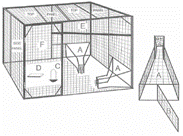Eastern Wildlife Damage Control Conferences

Eastern Wildlife Damage Management Conference: 8th (1997)
Date of this Version
October 1997
Document Type
Article
Abstract
Great blue herons (Ardea herodius) are the most common avian predator at commercial trout hatcheries in the northeastern United States. We evaluated a 2-strand electric fence for excluding this species from raceways at 2 commercial trout hatcheries in central Pennsylvania. Fences consisted of high density polyethylene 400-lb strength tape supported by fiberglass posts and energized by either a battery-powered or a solar-powered fence charger. Labor and material for constructing the fences at the 2 sites averaged $1.32/m of raceway. Bird visitation at the 2 sites initially declined, but returned to pre-installation levels. However, bird use of raceways declined (P<0.05) at both sites compared to pre-installation levels for the duration of the study (49-62 days post-installation). Fences must be monitored to detect electrical shortages and to ensure that birds do not gain access to raceways under the bottom strand of the fence or forage between the fence and the shoreline. The 2- strand fence evaluated in this study is a cost-effective method for deterring heron predation at commercial trout hatcheries.


Comments
Published in Proceedings of the Eighth Eastern Wildlife Damage Management Conference, Roanoke, Virginia, October 16–19, 1997, edited by James A. Parkhurst. Copyright © 1997 by the authors.